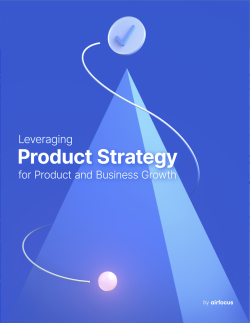Product Strategy
What is Product Strategy
Product strategy definition
Product strategy is a term used to describe a business’s vision and overarching objective for a product. Specifically, it will communicate the why behind all the work a product team engages in.
Everything related to the product will be affected by a good, intricate strategy. This is why it’s crucial to get right.
It’s more comprehensive and action-based than a simple plan. A product strategy isn’t a few lines scribbled on a notepad in the white heat of inspiration — it’s a clear guide to keeping a business focused on the main priorities.
Taking any product from the first idea to the customer is a challenge. But establishing a product strategy lays the foundations for a greater chance of success.
Yet product strategy can grow and evolve as the team gets to work, too — it shouldn’t be treated as if it were set in stone. Rather, the strategy should allow for lessons to be learned and new steps to be created.
The overall desired outcome may be adjusted, too, provided there’s a good reason to do so.
But regardless of any changes implemented, the product strategy should continue to focus on making a product that’s best for both the business and the buyers.
Your business should have in-depth buyer personas ready to inform the strategy: this helps you tailor the product to the people you want to attract rather than targeting a general audience.
Creating and maintaining a product strategy involves extensive work, of course, and small businesses may be reluctant to lengthen the production cycle any further. But bringing a product to market without conducting in-depth research and strategizing is a far bigger risk.
The benefits of having a product strategy
So, we know what a product strategy is. We’ve touched on the reasons it’s so important. But why should your team invest time, energy, and resources into creating a product strategy?
Here are the biggest benefits.
Accuracy, precision, clarity
Putting a product strategy into place empowers your team with a clear grasp of:
What the product is
Who it’s aimed at
Which pain points it addresses
When and where the USP is communicated
Why it’s right for your business
Everyone involved in the product’s conception, development, sales, and marketing will benefit from a well-designed product strategy. Focusing on the points listed above keeps your business focused on the key reasons why the product has to exist in the current marketplace and why buyers will want to pay for it.
Make better decisions and reduce the risk of time-wasting mistakes
There’s a certain degree of experimentation or trial-and-error in bringing any product to market. But small gambles that help you reach positive conclusions and make good decisions are entirely different from those which lead you down a dead end.
Creating an in-depth product strategy built on research and customer insights reduces the risk of wasting time on fruitless tasks. As we mentioned earlier, a product strategy allows for flexibility and alterations, but there’s still a roadmap to guide your team.
You’ll make smarter choices. You’ll be constantly working towards an outcome that’s in the best interests of both your audience and your business.
You’ll know what NOT to focus on
Developing a product strategy requires an understanding of what isn’t necessary in your product.
This kind of insight is garnered by conducting in-depth user research and customer analysis (which you may already have in the form of accurate buyer personas). These should be studied and referred to throughout the production cycle to ensure any product developments are in line with core market needs.
Examples of product strategy
A product strategy is made up of multiple components. As we said, it’s not just a few lines scribbled on paper — it’s a well-considered, step-by-step system based on data-driven information.
Here are the key elements you must implement into your product strategy to achieve success:
The vision
Every product stems from an idea. And the product vision is your team’s chance to define what that idea is, who the product is for, how it’ll improve their lives, and why it has to exist. It’s basically a statement for your product and its desired outcomes down the line.
For example, Teach for America’s vision statement is particularly inspiring: “One day, all children in this nation will have the opportunity to attain an excellent education”.
This makes Teach for America’s aspirations clear. It summarizes the impact the organization aims to make on society, and the future, in a single sentence. Any product strategy that Teach for America develops should, therefore, support that fundamental objective.
Objectives
While the product vision focuses on the product’s effects on consumers or the market, the next element is fixed on your goals.
What do you want this product to achieve for your business?
Double your ROI within a year?
Reach a new demographic?
Grow your list of subscribers?
These objectives should be concrete and actionable, not abstract. This informs your team’s work and strategies throughout the production cycle.
Customer feedback
Don’t forget to gather customer insights for your product strategy.
Send out questionnaires or present brief surveys on your website to pick prospects’ brains. Try to discern what matters to your audience, and why they choose your business over another. Work towards understanding their motivations, pain points, lifestyles, spending habits, budgets — everything that leads them to make that all-important purchase.
The more you know about your buyers, the more likely you are to retain their customs.
When do you need a product strategy?
A product strategy is crucial for any business, no matter how established they are. Launching into developing and releasing a product without this crucial documentation is a huge risk, even for global brands generating billions in revenue.
Creating a strategy ensures your product appeals to its target audience, serves a clear purpose, meets the standards of quality you want people to associate with your business, and aligns with consumer needs.
It can help you stand out in a crowded marketplace and minimize the danger of making costly mistakes.
Product strategy example: Spotify
Let's consider a real-world example to best understand what a product strategy firing on all cylinders looks like.
Perhaps the best-known streaming service in the world, Spotify is no slouch when it comes to product strategy – and the numbers back that up. 500 million users worldwide, and 205 million are active subscribers, making Spotify a true juggernaut in audio streaming subscriptions.
So how does Spotify’s product strategy fuel the platform’s need for more subscribers while minimizing churn?
At a high level, the key differentiators for Spotify’s product strategy include:
Leveraging data analytics and machine learning to improve user experience. With countless hours of listening data, Spotify’s platform can make data-driven decisions about what users might want to listen to and when. This makes music discoverability a key attractor for users.
Strategic partnerships. By signing deals with global celebrities and securing exclusivity for sought-after podcasts and shows, Spotify can deliver unique value other services can’t.
A robust freemium upsell strategy. Spotify boasts a huge base of free users but wants to convert them into paying customers. It does so through strategic offers, such as exclusive pricing for students and couples, and by making certain features available only to paid users. For example, Spotify restricts shuffle controls on its mobile apps as a way to encourage people to upgrade to premium.
Adaptability in a changing market. Spotify’s biggest strategic strength has been its ability to react to market dynamics. For example, Spotify introduced podcasts to its listener base in 2018 to capitalize on consumer trends toward podcast listening.
Spotify vs. Apple Music vs. Tidal
Spotify’s product strategy has also been uniquely tested by a fiercely competitive music streaming market, with multiple contenders vying for a slice of the pie.
Its two main competitors, Apple Music and Tidal have tried to dethrone Spotify as the leading music platform but have yet to be able to do so.
According to some, Apple Music has struggled to keep up with Spotify due to a lack of innovation and a focus on exclusives. While Apple Music has attempted to differentiate itself through exclusive album releases and partnerships with artists like Drake and Taylor Swift, these efforts have not been enough to grab significant market share.
Likewise, Tidal has tried to differentiate itself through “identity marketing.” This strategy includes exclusive offers and experiences, such as early access to concert tickets and behind-the-scenes content. While this approach has helped Tidal build a loyal customer base, again, it hasn’t been enough to knock Spotify off the top spot.
Spotify in numbers
So, if Spotify’s product strategy is so robust, how do the results stack up? Let’s look at some of the platform’s vital statistics.
As of 2022, Spotify holds a 31% market share of the music streaming market. That’s more than double its closest competitor, Apple Music, which holds just 15%.
According to HubSpot, Spotify’s monthly churn rate sits at just 3.9%, proving that its product strategy is well-positioned to retain users in the long term.
Spotify boasts 500 million users, including 205 million subscribers across over 180 markets.
The Spotify strategy — 3 key takeaways
It’s clear that even almost two decades after the company’s inception in 2006, Spotify’s product strategy is still robust enough to keep the platform in the top spot.
So what can other companies learn from Spotify’s example when developing their own product strategy?
Focus on user experience. By understanding what users want, Spotify has been able to offer personalized recommendations, playlists, and features that keep users coming back.
Personalize your product. Spotify's use of machine learning algorithms to personalize playlists and recommendations has been a major factor in its success.
Learn and adapt. Spotify has shown it’s always willing to respond to market trends, like podcasts, and adapts to artists’ needs, with open discussions about revenue sharing.

General FAQ

Glossary categories
Create effective product strategy

Experience the new way of doing product management








